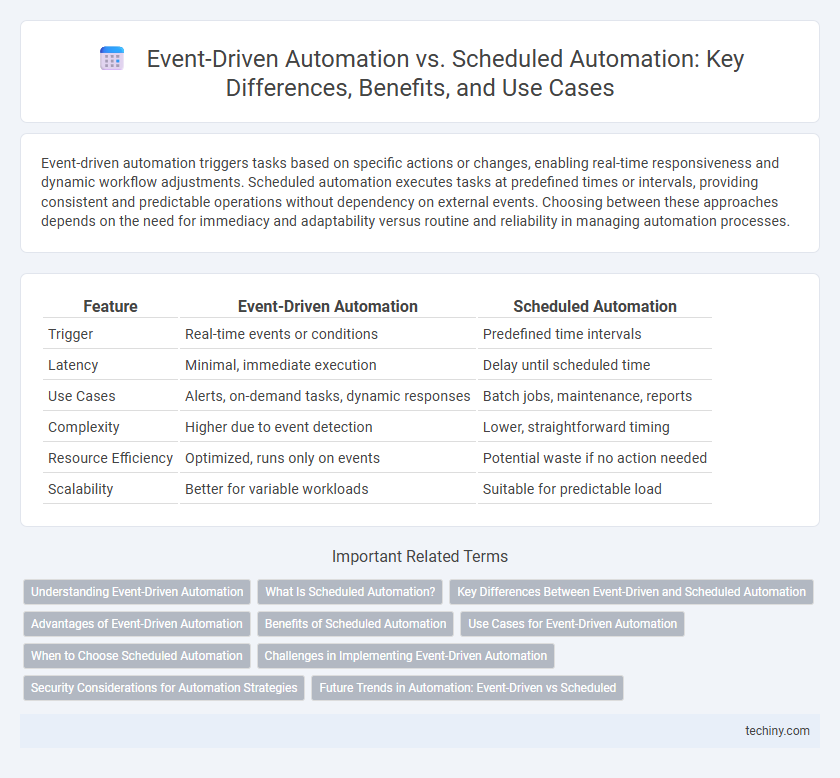Event-driven automation triggers tasks based on specific actions or changes, enabling real-time responsiveness and dynamic workflow adjustments. Scheduled automation executes tasks at predefined times or intervals, providing consistent and predictable operations without dependency on external events. Choosing between these approaches depends on the need for immediacy and adaptability versus routine and reliability in managing automation processes.
Table of Comparison
| Feature | Event-Driven Automation | Scheduled Automation |
|---|---|---|
| Trigger | Real-time events or conditions | Predefined time intervals |
| Latency | Minimal, immediate execution | Delay until scheduled time |
| Use Cases | Alerts, on-demand tasks, dynamic responses | Batch jobs, maintenance, reports |
| Complexity | Higher due to event detection | Lower, straightforward timing |
| Resource Efficiency | Optimized, runs only on events | Potential waste if no action needed |
| Scalability | Better for variable workloads | Suitable for predictable load |
Understanding Event-Driven Automation
Event-driven automation triggers workflows based on real-time events, enabling immediate responses to changes such as system alerts, user actions, or sensor data. This approach improves efficiency by processing tasks only when necessary, reducing resource consumption compared to scheduled automation, which runs tasks at predetermined intervals regardless of actual conditions. Event-driven automation is crucial in dynamic environments like IoT, cybersecurity, and real-time data processing, where responsiveness and precision are essential.
What Is Scheduled Automation?
Scheduled automation involves executing predefined tasks at specific times or intervals, such as daily backups or weekly reports. It relies on a fixed timetable, ensuring consistent and predictable operations without manual intervention. This approach is ideal for routine processes that do not require real-time responsiveness or immediate reaction to dynamic events.
Key Differences Between Event-Driven and Scheduled Automation
Event-driven automation triggers actions based on specific events or changes in data, ensuring real-time responsiveness and dynamic workflow adaptation. Scheduled automation runs tasks at predetermined times or intervals, providing consistent execution but lacking immediate reaction to system changes. The key difference lies in event-driven automation's ability to respond instantly to events, while scheduled automation operates on fixed timing regardless of system state.
Advantages of Event-Driven Automation
Event-driven automation triggers actions in real-time based on specific events, ensuring immediate response and reducing latency compared to scheduled automation, which operates at fixed intervals. This approach enhances system efficiency by processing events as they occur, leading to improved resource utilization and faster decision-making. Event-driven automation also increases scalability, as it dynamically adapts to workload variations without the need for constant monitoring or manual intervention.
Benefits of Scheduled Automation
Scheduled automation enables consistent task execution at predetermined times, ensuring reliable system maintenance and data processing without manual intervention. It improves operational efficiency by automating repetitive workflows based on fixed schedules, reducing the risk of human error and downtime. This method is ideal for routine activities like backups, report generation, and system updates, optimizing resource allocation and ensuring timely completion.
Use Cases for Event-Driven Automation
Event-driven automation excels in dynamic environments like real-time fraud detection, IT incident response, and supply chain management where immediate action is critical upon event occurrence. This approach enables systems to react instantly to triggers such as user activities, sensor alerts, or system failures, enhancing operational efficiency and minimizing downtime. Use cases include automated security alerts, real-time data processing, and adaptive customer support workflows that depend on timely, event-specific execution.
When to Choose Scheduled Automation
Scheduled automation is ideal for repetitive tasks that require execution at fixed intervals, such as daily data backups, report generation, or system maintenance checks. It ensures consistency and predictability by running workflows at predefined times, reducing the risk of missed processes in stable environments. Organizations relying on routine operations with minimal variability benefit most from scheduled automation frameworks.
Challenges in Implementing Event-Driven Automation
Implementing event-driven automation presents challenges such as handling unpredictable event patterns that require real-time processing capabilities and robust infrastructure to avoid bottlenecks. Integrating diverse data sources and ensuring accurate event detection demand sophisticated event correlation and filtering algorithms. Scalability and error management further complicate deployment, necessitating adaptive workflows that can dynamically respond to varying event volumes without system downtime.
Security Considerations for Automation Strategies
Event-driven automation enhances security by triggering actions instantly in response to specific events, enabling real-time threat mitigation and reducing vulnerability windows. Scheduled automation, while useful for routine maintenance, poses risks if update intervals are too long, potentially leaving systems exposed during downtime. Integrating real-time monitoring with automated event responses strengthens overall security posture by ensuring critical threats are addressed immediately.
Future Trends in Automation: Event-Driven vs Scheduled
Future trends in automation emphasize a shift from scheduled automation to event-driven automation, driven by the demand for real-time responsiveness and enhanced efficiency. Event-driven automation leverages intelligent triggers from data streams and IoT devices to initiate processes instantly, contrasting with scheduled automation's fixed-time execution. As enterprises adopt AI and edge computing, event-driven systems are expected to dominate, enabling adaptive workflows and reducing latency in dynamic environments.
Event-Driven Automation vs Scheduled Automation Infographic

 techiny.com
techiny.com